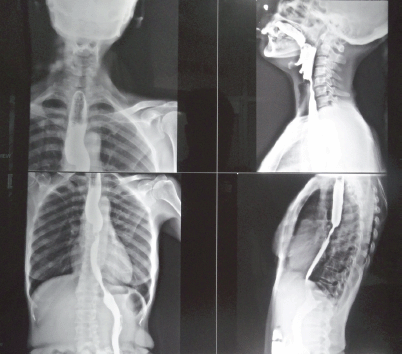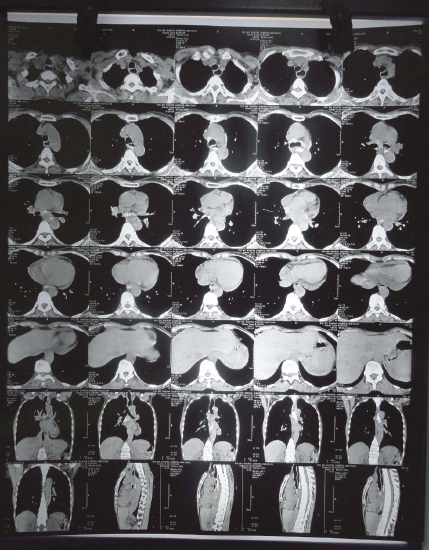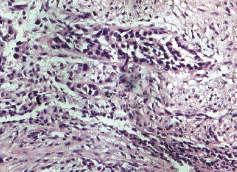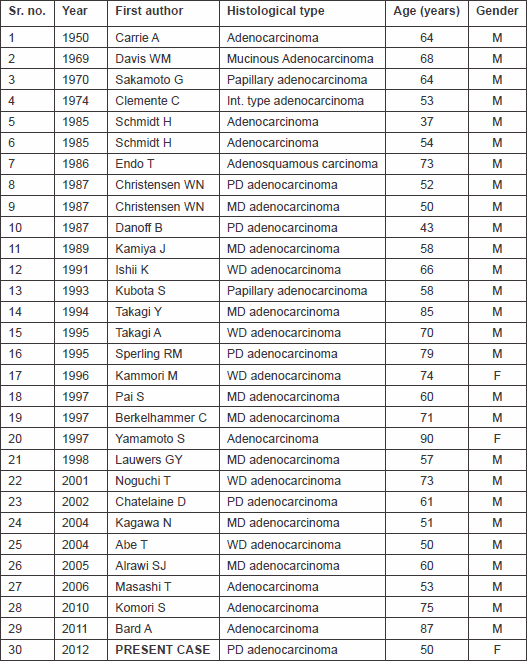Primary adenocarcinoma of the upper oesophagus
Yash P Verma 1, Ashok K Chauhan 1 and Rajiv Sen 2
1 Department of Radiotherapy, PGIMS Rohtak, India
2 Department of Pathology, PGIMS Rohtak, India
Correspondence to: Yash P Verma. Email: yashpverma@gmail.com
Abstract
Upper oesophageal adenocarcinoma is a rare malignancy that occurs in the ectopic gastric mucosa, in the upper part of the oesophagus. Only 29 cases so far have been reported. We report the 30th case in a 50-year-old Asian female presenting with difficulty in swallowing.
Keywords: oesophageal adenocarcinoma, middle oesophagus, rare, malignancy, radiotherapy.
Introduction
Upper oesophageal malignancies (proximal to gastro-oesophageal junction) are usually of the squamous cell type. Although glandular heterotropia of the upper digestive tract is frequently observed during upper gastrointestinal endoscopy (in 0.26%–4.9% of cases), it has rare malignant potential. Adenocarcinoma of the upper oesophagus is not commonly observed and only 29 cases have been reported so far [1–8]. We are reporting on the 30th case of adenocarcinoma of the upper oesophagus in an Asian female.
Case report
The 50-year-old patient, complained of progressive difficulty in swallowing for four months, having had only liquid intake at the time of our workup. There was no history of tuberculosis, hypertension, chronic obstructive pulmonary disease, diabetes, any other chronic ailment, or significant family history. Blood biochemistry, including liver and kidney functions, was within normal limits. Ultrasound of the patient’s abdomen was normal. A barium swallow (Figure 1) revealed a filling defect in the mid-thoracic oesophagus with shouldering effect and a hold-up of barium proximal to it. The CECT of the thorax (Figure 2) showed circumferential thickening of the oesophagus from carina to a distance of 4.5-cm. Fat plane with trachea and aorta was maintained. The gastro-oesophageal junction was not involved. The CECT of the abdomen showed normal liver, spleen, pancreas, and kidneys. No free fluid or lymphadenopathy was seen. Upper gastrointestinal endoscopy detected an ulcero-nodular, friable, obstructive growth at 22-cm from the incisor teeth; a scope negotiation below it was not possible. A biopsy (Figure 3) of growth revealed poorly differentiated adenocarcinomas. Alpha fetoprotein and serum transferrin were also within normal limits (3.1 ng/ml and 322 mg/dl). The option of surgery was given, but the patient was not willing to have any surgical intervention. In view of the moderate nutritional status and a poor oral intake, a palliative external beam radiotherapy (EBRT) was given; as 20-Gy in five fractions over five days by AP/PA fields, using telecobalt, along with supportive treatment. Oral intake and general condition improved in the following four weeks and supplementary EBRT as 12-Gy in six fractions over one week was given. Supplementary intraluminal brachytherapy was offered in view of the good response to radiotherapy, but the patient refused. At third monthly follow-up, the patient was having an adequate semisolid and occasionally solid diet. Her general condition also improved, with no additional complaints.

Figure 1: Barium swallow.

Figure 2: CECT Thorax.

Figure 3: Micropictograph of biopsy specimen.
Discussion
Occurrence of adenocarcinoma is rare and has been explained in the literature on the basis of ectopic gastric type mucosa in the upper part of the oesophagus. The incidence of ectopic gastric mucosa is 4.0% in males and 2.9% in females [9]. Table 1 summarizes all these cases including this case report.
Table 1: Summary of cases reported to date.

The age at presentation varies from 37 to 90 years with a mean age of 63 years. Out of 30 cases, only three are female with a male to female ratio of 9:1, which is a little higher than the ratio for overall oesophageal malignancies (3.5:1) [10]. In general, radical surgery is the mainstay of treatment. Radiotherapy is a good alternative, especially when surgery is refused or not feasible. Beyond doubt, treatment modality needs to be individualized based on disease, the patient’s condition, and other parameters. The gradual increase in the number of cases of upper oesophageal adenocarcinoma warrants the standardization of treatment protocol.
References
1. Komori S, Osada S, Tanaka Y, Takahashi T, Nagao N, Yamaguchi K, et al (2010) A case of esophageal adenocarcinoma arising from the ectopic gastric mucosa in the thoracic esophagus Rare Tumors 2(1) e5 (Published online 2010 March 31) DOI: 10.4081/rt.2010.e5 PMCID: 2994492
2. Bard A, Coton T, De Biasi C and Guisset M (2011) Adenocarcinoma of the upper esophagus Clin Res Hepatol Gastroenterol 35(5) 418–9 (Epub 2011 Feb 26) DOI: 10.1016/j.clinre.2011.01.010 PMID: 21354890
3. Noguchi T, Takeno S, Takahashi Y, et al (2001) Primary adenocarcinoma of the cervical esophagus arising from heterotopic gastric mucosa J Gastroenterol 36 704–9 DOI: 10.1007/s005350170035 PMID: 11686482
4. Chatelain D, de Lajarte-Thirouard AS, Tiret E and Flejou JF (2002) Adenocarcinoma of the upper esophagus arising in heterotopic gastric mucosa: common pathogenesis with Barrett’s adenocarcinoma? Virchows Arch 441(4) 406–11 DOI: 10.1007/s00428-002-0697-7
5. Kagawa N, Fukuda Y, Ishimoto T, et al (2004) A case of esophageal adenocarcinoma arising from ectopic gastric mucosa in the cervico-thoracic esophagus Jpn J Surg Association 65 2637–41 DOI: 10.3919/jjsa.65.2637
6. Abe T, Hosokawa M, Kusumi T, et al (2004) Adenocarcinoma arising from ectopic gastric mucosa in the cervical esophagus Am J Clin Oncol 27 644–5 DOI: 10.1097/01.coc.0000147808.63442.b5 PMID: 15577449
7. Alrawi SJ, Winston J, Tan D, et al (2005) Primary adenocarcinoma of cervical esophagus J Exp Clin Cancer Res 24 325–30 PMID: 16110768
8. Masashi T, Haruji O, Lee S, Takayuki N, Ken’ichiro F, Hiroshi I (2006) Primary adenocarcinoma of the upper to mid thoracic esophagus arising from the esophageal glands Surgery 68(5) 580–4
9. Nakajima H, Munakata A and Yoshida Y (1991) Endoscopic diagnosis and significance of islet patch Gastroenterological Endoscopy 33 1357–62
10. Jemal A, Siegel R, Ward E, et al (2007) Cancer statistics CA Cancer J Clin 57(1) 43–6 DOI: 10.3322/canjclin.57.1.43 PMID: 17237035






